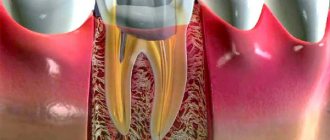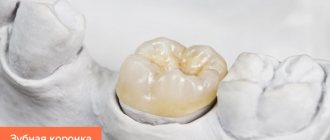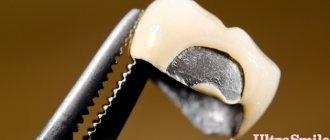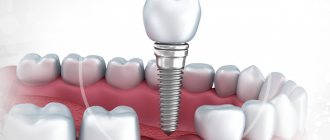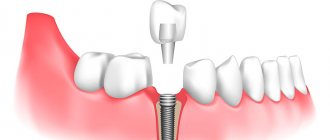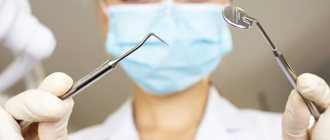Why does caries occur on young permanent teeth?
A teenager's permanent teeth have their own characteristics, and caries on them develops differently than on the teeth of an adult. That is why pediatric dentists treat caries in adolescents.
The fact is that a newly erupted tooth is vulnerable, since its mineralization remains low during the first year. Moreover, on molars and premolars, mineralization is finally completed only by 4-5 years after eruption. This is why the enamel on young permanent teeth of a teenager is still highly permeable, and the dentinal tubules are even wider than on baby teeth. As a result, the risk of caries is very high in the first year after eruption, and the rate of its development can be very fast.
Can a crown save teeth?
First, the tooth and periodontal tissue are treated, and only then prosthetics are performed. How long does it take to get a crown on a tooth? Metal-ceramics are made in a dental laboratory; installation will take from 7 days, and metal-free Cerec options will be ready in 1.5 hours. When replacing a tooth with a crown, a protective case is put on it, protecting the fragile remains, deprived of nutrition after removal of the neurovascular bundle, from further destruction and preventing secondary caries.
If one or two dental units are missing, a structure is created: a crown on the abutment tooth and a bridge.
This method allows you to preserve the volume of bone tissue and eliminate inconvenience in everyday life. In this case, crowns will save not only units, but also periodontal tissue.
How long does a tooth live under a crown? With high-quality work and installation in compliance with the nuances of technology, metal ceramics can last more than 10 years, ceramic options 15 years or longer, and zirconium - 20 years.
What is delayed caries treatment?
This technology allows you to treat caries on teeth that have not yet fully erupted. The treatment takes place in two stages.
- At the first stage, the doctor removes all tissue affected by caries. After such removal, the carious cavity is filled with therapeutic materials that release active anti-carious components, and a temporary filling is placed. This gives the young tooth the opportunity to mature and not decay. The treatment is temporary, the main task is to support the tooth until it erupts and matures.
- At the second stage of treatment, after 1, 3, 6 or 12 months, the temporary filling is completely removed, and mechanical treatment of the carious cavity is carried out again. As a rule, this procedure is practically painless due to the increased mineralization and density of dentin. After this, the doctor places a permanent filling.
Is it possible to restore a tooth again?
Today, there are frequent calls from patients whose teeth are destroyed, treated 7-10 or more years ago. Back then, old technologies were used, the materials had expired, and the tooth needed to be restored again.
Many people just want to grind down the tooth and put a crown on it. During the consultation, we consider all methods. If the tooth has been filled and there is a chip in the filling or wall, then by eliminating the defect, this is possible. But, when complex restoration has already been carried out, especially on the frontal units, canines, replacement of old structures is necessary.
If the tooth was strengthened with a metal pin, and the wall was built up with a composite material, which darkened over time and began to crack, then drastic intervention will be required. First, you need to free the tooth from used materials: remove the filling, remove the pin. If necessary, treat incipient caries (often the patient himself does not know about the developing process).
The best way out
– this is the installation of inlays or solid modules, crown plus tooth root, using Cerec.
The scanner will “notice” all the structural features of the tooth; the program takes into account not only the features of the unit, but also all the nuances of the bite. How long does it take to make such crowns or complete modules for teeth? Only 1.5 hours
, small temporary deviations are possible.
The new tooth will look natural. During the consultation, we will decide how to restore the unit, what kind of crown is needed for the tooth, and choose the technology. At my appointment, you will feel calm, absolutely not afraid. Believe me, I will find a way to save a tooth even in the most difficult cases.
Reasons for the development of childhood caries
Main risk factors:
- Excessive consumption of sweets. In this case, a harmful environment is formed in the child’s mouth, and the tooth enamel begins to suffer.
- Transmission of infection from relatives. This can happen when sharing utensils, adults licking a baby's spoon, and sometimes even kissing.
- Long contact with the bottle. This type of caries is called “bottle caries”. If a baby drinks a sweet liquid from a bottle and then falls asleep with it, then prolonged contact of the sweet with the teeth can lead to the rapid development of caries.
- Deficiency of fluoride and calcium in food.
- Lack of solid food. When chewing solid food, a lot of saliva is released, which naturally washes the oral cavity.
- The use of medications that change the composition of saliva.
- Chronic diseases.
- Improper care of baby teeth. Infants need to wipe their teeth from the moment they erupt - you can use ordinary gauze wrapped around your finger. It is very important for parents to teach older children to brush their teeth and use a brush, constantly remind them of this and monitor compliance with the procedures. The example of parents is a strong motivating factor here.
Filling materials
They can be very different. The most important thing when filling is to close the holes that have formed in the tooth. It is also necessary to restore the functions of the tooth. Therefore, when choosing a material, the location of the tooth and the possible load are taken into account.
If the chewing tooth is severely damaged, then polymers can be used; they can withstand heavy loads. As for the anterior teeth, light-curing composites are more often used here. With their help, you can create a shade that is most reminiscent of natural. For incisors and their filling, silicate and silicophosphate cements are usually used.
Materials must meet certain requirements. They should not dissolve in dental tissues, be easy to remove if repeated treatment is needed, not enter into a chemical reaction with the tooth, and ensure complete sealing of the tooth canals.
Temporary filling
Why a temporary filling is placed after root canal filling is a common question.
Root canal treatment is quite lengthy and often requires several visits to the dentist. Protection of open root canals from external flora at the time of treatment is one of the main indications why a temporary filling is placed after filling the canals. In addition, filling a tooth with a temporary filling is also carried out for therapeutic purposes - the material for such filling can be various medications (antibacterial, corticosteroid, antiseptic, antifungal pastes for filling).
The following reasons can be identified why a temporary filling is placed after canal filling:
- Root canal cleaning.
- Their disinfection - based on various observations, filling a tooth with a temporary filling can destroy up to 97% of bacteria.
- Preventing the development of the inflammatory process.
- Activation of regenerative processes in periodontium.
Thus, the main task of temporary filling is to prevent the development of complications and protect open canals during endodontic treatment.
Stages and technology
Today, they no longer remove a diseased tooth, but treat it. In case of caries, the doctor fills it. The service life of such a tooth will directly depend on the professionalism of the specialist and the quality of the material used.
Pain may occur during the procedure because the pulp contains nerve endings that immediately send a signal to the brain. But today there are many anesthetics that make the patient feel no pain.
If we talk about filling technology, it is divided into several stages:
- Initially, an anesthetic injection is given to relieve pain;
- carefully process, clean the area of the tooth that has been damaged by caries. If the pulp is inflamed, it is removed, after which the cavity is disinfected. If there are small areas of affected tissue under the filling, the inflammatory process will begin again;
- In case of minor damage to the teeth, a medical lining is placed. If the process is started, then the pins are installed;
- the material is selected, it all depends on several factors;
- An x-ray is taken to look at the result and make sure that the affected areas have been completely removed;
- The composite is sanded, and the filling is then coated with indelible varnish.
How to extend the service life of filling material
How often the filling will have to be changed depends on how correctly it is used. To extend the life of the material, just listen to the following tips:
- don’t skimp on material: very cheap means it won’t last long,
- avoid increased stress on the filling: do not open bottles, avoid excessively hard foods,
- avoid sudden changes in temperature in the oral cavity: do not take too hot or cold food,
- select oral hygiene items and products in accordance with the characteristics of the teeth.
In addition, even in the absence of complaints, you need to regularly visit the dentist for timely detection of pathologies and defects. It is better to spend a few minutes grinding than to have to refill it after some time. Preventative visits will save time and money, and will also keep your nerves and teeth in perfect order.
Is it painful to have a filling?
Modern medicine has made great progress to make patients feel comfortable being treated. Therefore, today few people are afraid to go to a specialist and have their teeth treated.
You can also choose any anesthetic to remove the hellish pain that people used to feel during the treatment of dental caries. Moreover, the choice is so large that even an allergy sufferer can choose the right material. Just a few injections into the gum area and the patient does not feel pain for some time. There is only slight sensitivity after the procedure, but it will go away after 2 days.
The use of anesthesia in children for dental treatment
Local anesthesia
As a rule, dental treatment in children takes place under local anesthesia - application (without an injection) and infiltration (with an injection). The first provides superficial anesthesia, but it cannot be called completely harmless - a child can swallow a solution containing a high concentration of lidocaine. The injection is more reliable because it completely blocks pain.
Anesthesia
Dental treatment for children is associated with certain problems: one child is restless and hyperactive, another is afraid of the doctor and refuses to open his mouth. But teeth need to be treated, so in some cases general anesthesia remains the only option. In Western countries, this method has been used for a long time to treat diseased teeth in children over 1 year old. There is an opinion that anesthesia can affect memory and interfere with the normal development of speech. This is theoretically possible, but in practice this is an exceptional case. The cause of complications is not anesthesia, but the stress that the child received. Chronic disease may also manifest itself in combination with general anesthesia. However, without it it is impossible to cure multiple bottle caries in one go. The child simply cannot withstand 2 hours of necessary manipulations and filling of all teeth.
Before using general anesthesia, a number of studies are required:
- general blood analysis;
- biochemical studies;
- blood sugar level;
- electrocardiography.
Before the operation, you should not eat for 6 hours; 4 hours before the introduction of anesthesia you will have to stop taking any liquid, including water. The child is gently put to sleep with a gaseous sedative based on sevoflurane. He will wake up immediately after increasing the dose of oxygen. All reflexes return to normal within 15 minutes.
Contraindications to general anesthesia
Even a minor cold is a contraindication for anesthesia. After any illness, at least 2 weeks must pass. No vaccinations should be carried out 2 weeks before anesthesia and 2 weeks after it.
Why do you need a temporary filling?
Temporary filling of root canals is an optional step in endodontic treatment. Indications for its implementation are various conditions and diseases, which we will discuss below.
For therapeutic purposes, temporary canal filling can last for several weeks, but usually the temporary filling is replaced with a permanent one at the next visit to the dentist. The main tasks performed by temporary filling of root canals are their complete disinfection, treatment of the pulp, if appropriate, elimination and prevention of inflammatory processes, monitoring the effectiveness of root canal treatment (the paste that is used during temporary filling is visualized on x-ray).

